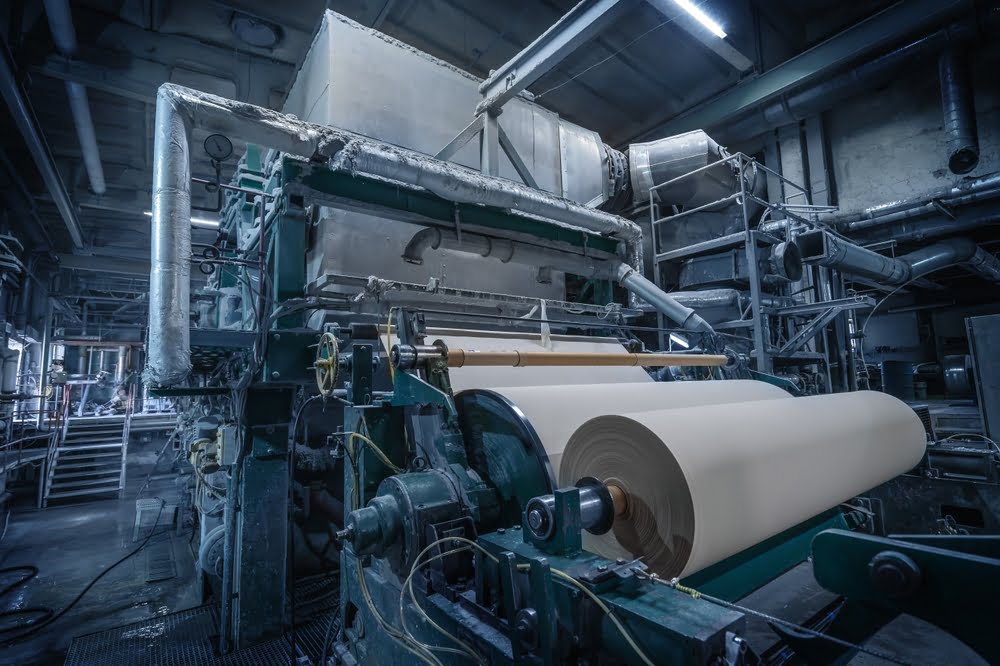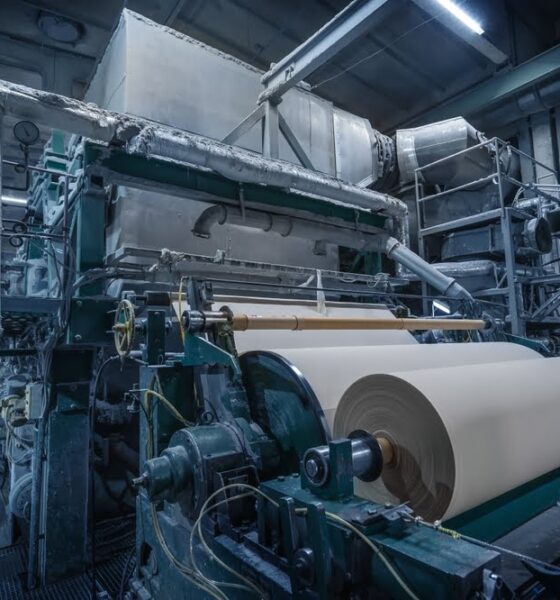

Business
The Pulp & Paper Industry is Reaching its Sustainability Goals
In 2015, all of the Member States of the United Nations agreed to adopt the 2030 Agenda for Sustainable Development. The Agenda is essentially an action plan detailing methods to create peace and prosperity for the planet and all of its people presently and in the future.
At the core of this Agenda are 17 Sustainable Development Goals (SDGs), which seek to preserve our forests and oceans, tackle climate change, and minimise the effects of the latter felt by people and communities worldwide. The SDGs also touch on key aspects of community development such as achieving gender equality, uplifting marginalised communities, and striving for the empowerment of women and young girls.
One industry which has received increased scrutiny and attention in relation to the SDGs is the pulp and paper sector, mainly revolving around critiques of resource usage and contributions to environmental degradation. In response, many pulp and paper companies such as Asia Pulp and Paper (APP) Sinar Mas have taken the initiative to weave the SDGs into their long-term sustainability commitments. In this context, the SDGs are a useful third-party benchmark against which an organisation’s sustainability and CSR initiatives can be drafted, planned, implemented, and assessed.
Forging a New Road Ahead for the Pulp and Paper Industry
In order for the pulp and paper industry to put its ‘best foot forward’ in regard to setting and achieving feasible sustainability goals by 2030, it is crucial that companies come up with a comprehensive strategy and roadmap to measure progress against. From amplifying best practices in forest management at the production level to initiating community development programmes in concession areas, the strategy should cover all aspects of the business where possible.
Asia Pulp and Paper’s own SDG-focused sustainability commitments were first outlined in its Sustainability Roadmap: Vision 2020, and subsequently expanded upon in the Sustainability Roadmap: Vision 2030, following an assessment of the SRV 2020 outcomes. The organisation’s roadmaps are further delineated into Production-, Forest-, and People-focused initiatives and programmes.
Pulp and paper companies in Hong Kong and throughout the Asia-Pacific region looking to strengthen their long-term sustainability commitments can look to Asia Pulp & Paper’s ongoing sustainable development initiatives as a blueprint.
1. Fibre Sourcing Commitments
Being an industry focused on primary- and secondary-level production, it’s crucial that pulp and paper companies begin from the ground up with their sustainability goals. This can primarily be achieved through fibre sourcing commitments that ensure fibre sources and suppliers are being held accountable to responsible sourcing frameworks. This also aligns them with SDGs 12, 13, and 15, amongst others.
One initiative that companies can turn to for more information on certification is the Programme for the Endorsement of Forest Certification (PEFC), which lays out standards on the chain of custody certification for forest- and tree-based products.
Companies can and should also create, where resources allow, their own internal frameworks to facilitate the implementation of PEFC standards and other certification criteria. In the case of Asia Pulp and Paper, the organisation developed its own internal Supplier Evaluation and Risk Assessment (SERA) tools to facilitate the implementation of its Responsible Fiber Procurement and Purchasing Policy (RFPPP) across all suppliers. The SERA tools employed by Asia Pulp & Paper examine multiple criteria relevant to responsible forestry including a chain of custody system, protection of High Conservation Values (HCV) or High Carbon Stock (HCS), and the supplier’s respect for the health and safety of forest workers.
Suppliers that wish to work with Asia Pulp & Paper are required to not only pass the initial SERA screening but subsequent annual reevaluations.
Asia Pulp & Paper has since managed to achieve 100% independent third-party verification for pulpwood legality by 2012, 100% sustainable plantation wood for pulp by 2013, and 100% sustainable forest management (SFM) certified pulpwood as of 2020 – all in line with their 2020 Roadmap. The organisation’s future sustainability goals build on these achievements and seek to source only from certified Sustainable Forests as well as increase fibre productivity by 2030.
2. Forest Conservation Policy
Forest conservation is a very important sustainability goal. Pulp and paper companies also need to recognise the importance of overall forest management when crafting initiatives to enhance the sustainability goals of their production policies and processes. This necessitates looking beyond just the suppliers and concession areas to understand how their programmes affect the wider forests and communities beyond.
For example, the fibre sourcing commitments made by Asia Pulp and Paper are only one aspect of its broader Forest Conservation Policy (FCP). The FCP includes commitments to develop only non-forested areas identified through HCV or HCS assessments, foster traceable relationships with responsible third-party suppliers, and principles looking at the organisation’s social and community engagement with villages in and around the concession areas.
3. Carbon Footprint Commitments
After ensuring the traceability and sustainability of their sources, pulp and paper companies should next turn to examine their carbon footprint by maximising energy efficiency through the use of renewable fuel sources, reduction of fossil fuel usage, and monitoring of water usage are all key to decreasing the overall carbon footprint of the production process.
Through a combination of measures such as the ones outlined above, Asia Pulp and Paper has managed to decrease their carbon intensity by 29% in 2020 compared to their 2012 baseline, and decreased their energy intensity by 14% by the same metrics. Similar progress has been made in the areas of water and solid waste management, in line with meeting SDGs 6, 7, 9, 12, and 13.
Most importantly, efforts to build a sustainable pulp and paper production process should not stop even after a sustainability goal has been reached. Asia Pulp & Paper, for example, is seeking to achieve a 30% reduction in their overall carbon footprint as part of their 2030 sustainability goals. The organisation is also seeking to increase the biodegradability and resource efficiency of their products through innovative R&D mechanisms – helping Asia Pulp & Paper enter the circular economy while still prioritising competitive business strategies.
4. Community Development Policies
Beyond production-related sustainability policies and forest-related sustainability policies, pulp and paper companies should recognise that the best sustainability goals seek to uplift and empower the communities around them. This includes the organisation’s employees, stakeholders, suppliers, and those who live in or around the concession areas affected by their area of work.
Community development and empowerment initiatives – whether internal or external – should ensure that all stakeholders and workers are given access to sustainable livelihoods and transparent processes for workforce management. Asia Pulp and Paper has put into place several programmes targeting employee and stakeholder welfare, with their most notable programme being Desa Makmur Peduli Api (DMPA).
DMPA intends to provide forest communities around Asia Pulp & Paper’s concession areas with alternative livelihood sources through sustainable agroforestry. This not only gives the villages more reliable economic opportunities, but discourages the use of negative practices such as slash-and-burn that they might have previously relied on.
Moving towards a greener, cleaner future in pulp and paper
The majority of the world’s population are keenly focused on doing whatever it takes to fight climate change and lead more sustainable lives – and this is being reflected in their purchasing decisions as well. Where there are options of who to purchase goods from and one business is environmentally responsible while the other is less so, customers will opt for the former even if it costs them more.
Simply put, there are now financial and economic incentives for companies to pursue and integrate sustainable development into their overall operations. In order to successfully implement a comprehensive roadmap for a sustainable future, pulp and paper companies should be prepared to set tangible and meaningful sustainability goals that they can hold themselves accountable to. Drawing on the success and continued progress of companies such as Asia Pulp and Paper, it’s possible for pulp and paper companies in Hong Kong and across the globe to seek out new ways to move towards a greener future for all.






























